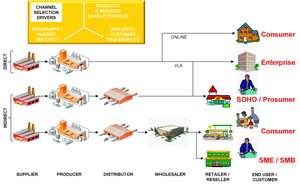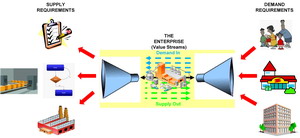Segmentation Model Layer
The very first step in our business architecture routemap is not even an essential one for all organisations. But for those to whom it applies it is VERY important. In short it applies by degree to any organisation with more than just a few types of customer and routes to market.
 Segmentation, both of the external marketplace, and of your organisation’s internal value streams, is essential to maximising the efficiency and effectiveness….and hence the profitability and customer satisfaction ratings……of most organisations. There are many grievous examples of the opposite effect in organisations who have not heeded this advice!
Segmentation, both of the external marketplace, and of your organisation’s internal value streams, is essential to maximising the efficiency and effectiveness….and hence the profitability and customer satisfaction ratings……of most organisations. There are many grievous examples of the opposite effect in organisations who have not heeded this advice!
Essentially, segmentation just means that one size often does not fit all. All customers are not the same (e.g. business customer versus consumer), not all customers buy in the same way (e.g. prefer retail outlet versus Internet purchase) and not all products or services can be provided via the same assets in the same facility (e.g. you don’t make nuts & bolts in a chocolate factory)!
A segmentation model simply recognises these basic facts of life…..and before you say this is soooooo obvious…….we know of many large organisations who should know better and who have ignored or missed this very basic point by varying degrees……ALWAYS to their detriment!!
Market segmentation maps the most appropriate ‘route to market’ sales channels for the products and services being examined onto different customer segments based on factors such as the related customer buying habits, preferences and requirements. A typical example of this is illustrated in the figure below (click on it to see an enlarged version in a new window).
Obviously your organisation will have to develop an equivalent market segmentation model relevant to your own markets, customers, channels, products and services. This work will help you to understand and specify more fully what externally facing processes your organisation will actually need in the Process Modelling of the next step in the business architecture routemap.
You will probably not now be surprised to learn that there is an internally facing corollary to this. That the differentiated demands of the marketplace for products and services can and often does in turn have implications for how an organisation sells, produces, delivers and supports those products and services.
Value stream segmentation translates this external market demand into key internal operating principles for an organisation. These principles then frequently manifest themselves in physical or virtual differences in site locations, processes, systems, production layouts and the like.
An illustration of how market demand requirements are reflected back into the internal value stream workings of an organisation is depicted in the figure below (click on it to see an enlarged version in a new window).
Again, you must make the translation from the demands of your external market segments to how they are reflected into your internal value streams in a way that relates to your organisations own circumstances.
Although strictly speaking beyond the scope of the discussion here, and allowing that there is more than one way to accomplish it, we ourselves would point you in the direction of Lean-Six-Sigma. Techniques such as Taxonomy Definition, Group Technology Clustering, Glenday Sieve Analysis, and Value Stream Codification and Mapping. These are all parts of our favoured approach to solving the translation to a value stream segmentation solution.
This work will again help you understand and specify more fully what sorts of internally facing processes your organisation will actually need in the Process Modelling of the next step in the business architecture routemap.
Still not convinced that this dissertation on segmentation has anything much to do with business architecture? Well, in some fairly trivial and uncommon cases, you might be correct….it has little of value to offer.
 For the remainder of cases, however, it has PLENTY to do with it. In a nutshell, in the most extreme case, what if you were to find that your customer market segments and sales channels needed to be very different for different product and service combinations? And further that these differences when reflected back into the value streams of your organisation demanded different types of processes, capacity and systems solutions for each combination?
For the remainder of cases, however, it has PLENTY to do with it. In a nutshell, in the most extreme case, what if you were to find that your customer market segments and sales channels needed to be very different for different product and service combinations? And further that these differences when reflected back into the value streams of your organisation demanded different types of processes, capacity and systems solutions for each combination?
What this extreme case scenario would be saying to you is that you are in fact running several different types of business! Yes, they may have similarities in that they all have finance, sales, etc requirements (i.e. from the ‘100,000 foot’ view)…..but look more closely and you will see from a ‘ground level’ view that there are many legitimate differences in how these requirements must be delivered to maximise marketplace, financial and operational effectiveness.
In short, in the most extreme cases, it may be better to develop separate business architectures for each business type rather than to try and fit them all into a single architecture framework…..with all the complexities, challenges and compromises implied by trying to do so!!
 More prosaically, however, what transpires in the more general case is that the single business architecture being built may need to be tweaked, be slightly extended or be part of a small ‘architecture family’ consisting of a few minor variants that reflect important differences in marketplaces and value streams. This solution combines the simplicity of having a single common ‘central’ architecture but allows some add-ons and extensions around it to recognise key differences and distinctions!
More prosaically, however, what transpires in the more general case is that the single business architecture being built may need to be tweaked, be slightly extended or be part of a small ‘architecture family’ consisting of a few minor variants that reflect important differences in marketplaces and value streams. This solution combines the simplicity of having a single common ‘central’ architecture but allows some add-ons and extensions around it to recognise key differences and distinctions!
 If the content of this webpage makes you feel that being a member of our Biz4ge Network, or a Certified Affiliate within it, would be of benefit to you please Contact Us and we will get in touch by return. Your contact will be treated as confidential and will be at no cost or obligation to you.
If the content of this webpage makes you feel that being a member of our Biz4ge Network, or a Certified Affiliate within it, would be of benefit to you please Contact Us and we will get in touch by return. Your contact will be treated as confidential and will be at no cost or obligation to you.


